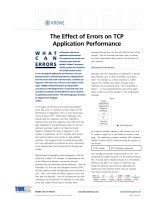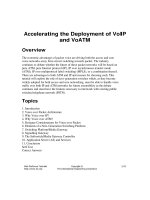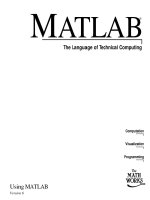Tài liệu SCRIBE: The design of a large-scale event notification infrastructure? doc
Bạn đang xem bản rút gọn của tài liệu. Xem và tải ngay bản đầy đủ của tài liệu tại đây (393.12 KB, 13 trang )
SCRIBE: The design of a large-scale event notification
infrastructure
Antony Rowstron , Anne-Marie Kermarrec , Miguel Castro , and Peter Druschel
Microsoft Research,
7 J J Thomson Avenue, Cambridge, CB3 0FB, UK.
antr,anne-mk,
Rice University MS-132, 6100 Main Street,
Houston, TX 77005-1892, USA.
Abstract. This paper presents Scribe, a large-scale event notification infrastruc-
ture for topic-based publish-subscribe applications. Scribe supports large num-
bers of topics, with a potentially large number of subscribers per topic. Scribe is
built on top of Pastry, a generic peer-to-peer object location and routing substrate
overlayed on the Internet, and leverages Pastry’s reliability, self-organization and
locality properties. Pastry is used to create a topic (group) and to build an ef-
ficient multicast tree for the dissemination of events to the topic’s subscribers
(members). Scribe provides weak reliability guarantees, but we outline how an
application can extend Scribe to provide stronger ones.
1 Introduction
Publish-subscribe has emerged as a promising paradigm for large-scale, Internet based
distributed systems. In general, subscribers register their interest in a topic or a pattern
of events and then asynchronously receive events matching their interest, regardless
of the events’ publisher. Topic-based publish-subscribe [1–3] is very similar to group-
based communication; subscribing is equivalent to becoming a member of a group. For
such systems the challenge remains to build an infrastructure that can scale to, and
tolerate the failure modes of the general Internet.
Techniques such as SRM (Scalable Reliable Multicast Protocol) [4] or RMTP (Re-
liable Message Transport Protocol) [5] have added reliability to network-level IP mul-
ticast [6, 7] solutions. However, tracking membership remains an issue in router-based
multicast approaches and the lack of wide deployment of IP multicast limits their ap-
plicability. As a result, application-level multicast is gaining popularity. Appropriate
algorithms and systems for scalable subscription management and scalable, reliable
propagation of events are still an active research area [8–11].
Recent work on peer-to-peer overlay networks offers a scalable, self-organizing,
fault-tolerant substrate for decentralized distributed applications [12–15]. Such systems
Appears in the proceedings of 3rd International Workshop on Networked Group Communica-
tion (NGC2001), UCL, London, UK, November 2001.
offer an attractive platform for publish-subscribe systems that can leverage these prop-
erties. In this paper we present Scribe, a large-scale, decentralized event notification in-
frastructure built upon Pastry, a scalable, self-organizing peer-to-peer location and rout-
ing substrate with good locality properties [12]. Scribe provides efficient application-
level multicast and is capable of scaling to a large number of subscribers, publishers
and topics.
Scribe and Pastry adopt a fully decentralized peer-to-peer model, where each partic-
ipating node has equal responsibilities. Scribe builds a multicast tree, formed by join-
ing the Pastry routes from each subscriber to a rendez-vous point associated with a
topic. Subscription maintenance and publishing in Scribe leverages the robustness, self-
organization, locality and reliability properties of Pastry. Section 2 gives an overview
of the Pastry routing and object location infrastructure. Section 3 describes the basic
design of Scribe and we discuss related work in Section 4.
2 Pastry
In this section we brieflysketch Pastry [12]. Pastry forms a secure, robust,self-organizing
overlay network in the Internet. Any Internet-connected host that runs the Pastry soft-
ware and has proper credentials can participate in the overlay network.
Each Pastry node has a unique, 128-bit nodeId. The set of existing nodeIds is uni-
formly distributed; this can be achieved, for instance, by basing the nodeId on a secure
hash of the node’s public key or IP address. Given a message and a key, Pastry reliably
routes the message to the Pastry node with a nodeId that is numerically closest to the
key, among all live Pastry nodes. Assuming a Pastry network consisting of
nodes,
Pastry can route to any node in less than
steps on average ( is a configura-
tion parameter with typical value 4). With concurrent node failures, eventual delivery is
guaranteed unless
nodes with adjacent nodeIds fail simultaneously ( is a config-
uration parameter with typical value
).
NodeId 10233102
-0-2212102
1
-2-2301203 -3-1203203
0
1-1-301233 1-2-230203 1-3-021022
Routing table
10-0-31203 10-1-32102
2
10-3-23302
102-0-0230 102-1-1302 102-2-2302
3
1023-0-322 1023-1-000 1023-2-121
3
10233-0-01
1
10233-2-32
0
102331-2-0
2
Neighborhood set
13021022 10200230 11301233 31301233
02212102 22301203 31203203 33213321
Leaf set
10233033 10233021 10233120 10233122
10233001 10233000 10233230 10233232
LARGERSMALLER
Fig.1. State of a hypothetical Pastry node
with nodeId 10233102,
. All numbers
are in base 4. The top row of the routing ta-
ble represents level zero. The neighborhood
set is not used in routing, but is needed dur-
ing node addition/recovery.
The tables required in each Pastry
node have only
entries, where each entry maps a
nodeId to the associated node’s IP ad-
dress. Moreover, after a node failure or
the arrival of a new node, the invari-
ants in all affected routing tables can
be restored by exchanging
messages. In the following, we briefly
sketch the Pastry routing scheme. A full
description and evaluation of Pastry can
be found in [12].
For the purposes of routing, nodeIds
and keys are thought of as a sequence
of digits with base
. A node’s routing
table is organized into
rows
with entries each. The en-
tries in row
of the routing table each
refer to a node whose nodeId matches
the present node’s nodeId in the first
digits, but whose th digit has one of the possible values other than the
th digit in the present node’s id. The uniform distribution of nodeIds ensures an
even population of the nodeId space; thus, only
levels are populated in the
routing table. Each entry in the routing table refers to one of potentially many nodes
whose nodeId have the appropriate prefix. Among such nodes, the one closest to the
present node (according to a scalar proximity metric, such as the delay or the number
of IP routing hops) is chosen in practice.
In addition to the routing table, each node maintains IP addresses for the nodes in its
leaf set, i.e., the set of nodes with the
numerically closest larger nodeIds, and the
nodes with numerically closest smaller nodeIds, relative to the present node’s nodeId.
Figure 1 depicts the state of a hypothetical Pastry node with the nodeId 10233102 (base
4), in a system that uses 16 bit nodeIds and a value of
.
In each routing step, a node normally forwards the message to a node whose nodeId
shares with the key a prefix that is at least one digit (or
bits) longer than the prefix
that the key shares with the present node’s id. If no such node is found in the routing
table, the message is forwarded to a node whose nodeId shares a prefix with the key as
long as the current node, but is numerically closer to the key than the present node’s id.
Such a node must be in the leaf set unless the message has already arrived at the node
with numerically closest nodeId or its neighbor. And, unless
adjacent nodes in
the leaf set have failed simultaneously, at least one of those nodes must be live.
2.1 Locality
Next, we discuss Pastry’s locality properties, i.e., the properties of Pastry’s routes with
respect to the proximity metric. The proximity metric is a scalar value that reflects the
“distance” between any pairof nodes, such as the numberofIP routinghops,geographic
distance, delay, or a combination thereof. It is assumed that a function exists that allows
each Pastry node to determine the “distance” between itself and a node with a given IP
address.
We limit our discussion to two of Pastry’s locality properties that are relevant to
Scribe. The first property is the total distance, in terms of the proximity metric, that
messages are traveling along Pastry routes. Recall that each entry in the node routing
tables is chosen to refer to the nearest node, according to the proximity metric, with the
appropriate nodeId prefix. As a result, in each step a message is routed to the nearest
node with a longer prefix match. Simulations show that, given a network topology based
on the Georgia Tech model [16], the average distance traveled by a message is less than
66% higher than the distance between the source and destination in the underlying
Internet.
Let us assume that two nodes within distance
from each other route messages
with the same key, such that the distance from each node to the node with nodeId clos-
est to the key is much larger than
. The second locality property is concerned with
the “distance” the messages travel until they reach a node where their routes merge.
Simulations show that the average distance traveled by each of the two messages be-
fore their routes merge is approximately equal to the distance between their respective
source nodes. These properties have a strong impact on the locality properties of the
Scribe multicast trees, as explained in Section 3.
2.2 Node addition and failure
A key design issue in Pastry is how to efficiently and dynamically maintain the node
state, i.e., the routing table, leaf set and neighborhood sets, in the presence of node
failures, node recoveries, and new node arrivals. The protocol is describedand evaluated
in [12].
Briefly, an arriving node with the newly chosen nodeId
can initialize its state by
contacting a nearby node
(according to the proximity metric) and asking to route a
special message using
as the key. This message is routed to the existing node with
nodeId numerically closest to
. then obtains the leaf set from , the neighborhood
set from
, and the th row of the routing table from the th node encountered along the
route from
to . One can show that using this information, can correctly initialize
its state and notify nodes that need to know of its arrival, thereby restoringall of Pastry’s
invariants.
To handle node failures, neighboringnodes in the nodeId space (which are aware of
each other by virtue of being in each other’s leaf set) periodically exchange keep-alive
messages. If a node is unresponsive for a period
, it is presumed failed. All members
of the failed node’s leaf set are then notified and they update their leaf sets to restore
the invariant. Since the leaf sets of nodes with adjacent nodeIds overlap, this update
is trivial. A recovering node contacts the nodes in its last known leaf set, obtains their
current leaf sets, updates its own leaf set and then notifies the members of its new leaf
set of its presence. Routing table entries that refer to failed nodes are repaired lazily;
the details are described in [12].
2.3 Pastry API
In this section, we briefly describe the application programming interface (API) ex-
ported by Pastry which is used in the Scribe implementation. The presented API is
slightly simplified for clarity. Pastry exports the following operations:
route(msg,key) causes Pastry to route the given message to the node with nodeId nu-
merically closest to key, among all live Pastry nodes.
send(msg,IP-addr) causes Pastry to send the given message to the node with the spec-
ified IP address, if that node is live. The message is received by that node through the
deliver method.
Applications layered on top of Pastry must export the following operations:
deliver(msg,key) called by Pastry when a message is received and the local node’s
nodeId is numerically closest to key among all live nodes, or when a messageis received
that was transmitted via send, using the IP address of the local node.
forward(msg,key,nextId) called by Pastry just before a message is forwarded to the
node with nodeId = nextId. The application may change the contents of the message or
the value of nextId. Setting the nextId to NULL will terminate the message at the local
node.
In the following section, we will describe how Scribe is layered on top of the Pastry
API. Other applications built on top of Pastry include PAST, a persistent, global storage
utility [17,18].
3 Scribe
Any Scribe node may create a topic; other nodes can then register their interest in the
topic and become a subscriber to the topic. Any Scribe node with the appropriate cre-
dentials for the topic can then publish events, and Scribe disseminates these events to
all the topic’s subscribers. Scribe provides a best-effort dissemination of events, and
specifies no particular event delivery order. However, stronger reliability guarantees
and ordered delivery for a topic can be built on top of Scribe, as outlined in Section 3.2.
Nodes can publish events, create and subscribe to many topics, and topics can have
many publishers and subscribers. Scribe can support large numbers of topics with a
wide range of subscribers per topic, and a high rate of subscriber turnover.
Scribe offers a simple API to its applications:
create(credentials, topicId) creates a topic with topicId. Throughout, the credentials
are used for access control.
subscribe(credentials, topicId, eventHandler) causes the local node to subscribe to
the topic with topicId. All subsequently received events for that topic are passed to the
specified event handler.
unsubscribe(credentials, topicId) causes the local node to unsubscribe from the topic
with topicId.
publish(credentials, topicId, event) causes the event to be published in the topic with
topicId.
Scribe uses Pastry to manage topic creation, subscription, and to build a per-topic
multicast tree used to disseminate the events published in the topic. Pastry and Scribe
are fully decentralized, all decisions are based on local information, and each node has
identical capabilities. Each node can act as a publisher, a root of a multicast tree, a
subscriber to a topic, a node within a multicast tree, and any sensible combination of
the above. Much of the scalability and reliability of Scribe and Pastry derives from this
peer-to-peer model.
3.1 Scribe Implementation
A Scribe system consists of a network of Pastry nodes, where each node runs the Scribe
application software. The Scribe software on each node provides the forward and de-
liver methods, which are invoked by Pastry whenever a Scribe message arrives. The
pseudo-code for these Scribe methods, simplified for clarity, is shown in Figure 2 and
Figure 3, respectively.
Recall that the forward method is called whenever a Scribe message is routed
through a node. The deliver method is called when a Scribe message arrives at the node
(1) forward(msg, key, nextId)
(2) switch msg.type is
(3)
SUBSCRIBE : if !(msg.topic topics)
(4) topics = topics
msg.topic
(5) msg.source = thisNodeId
(6) route(msg,msg.topic)
(7) topics[msg.topic].children
msg.source
(8) nextId = null // Stop routing the original message
Fig.2. Scribe implementation of forward.
(1) deliver(msg,key)
(2) switch msg.type is
(3)
CREATE : topics = topics msg.topic
(4)
SUBSCRIBE : topics[msg.topic].children msg.source
(5)
PUBLISH : node in topics[msg.topic].children
(6) send(msg,node)
(7) if subscribedTo(msg.topic)
(8) invokeEventHandler(msg.topic, msg)
(9)
UNSUBSCRIBE : topics[msg.topic].children =
topics[msg.topic].children - msg.source
(10) if (
topics[msg.topic].children =0)
(11) msg.source = thisNodeId
(12) send(msg,topics[msg.topic].parent)
Fig.3. Scribe implementation of deliver.
with nodeIdnumerically closest to the message’s key, or when a message was addressed
to the local node using the Pastry send operation. The possible message types in Scribe
are
SUBSCRIBE, CREATE, UNSUBSCRIBE and PUBLISH; the roles of these messages are
described in the next sections.
The following variables are used in the pseudocode: topics is the set of topics that
the local node is aware of, msg.source is the nodeId of the message’s source node,
msg.event is the published event (if present), msg.topic is the topicId of the topic and
msg.type is the message type.
Topic Management Each topic has a unique topicId. The Scribe node with a nodeId
numerically closest to the topicId acts as the rendez-vous point for the associated topic.
The rendez-vous point forms the root of a multicast tree created for the topic.
To create a topic, a Scribe node asks Pastry to route a
CREATE message using the
topicId as the key (e.g. route(
CREATE,topicId)).Pastry delivers this message to the node
with the nodeId numerically closest to topicId. The Scribe deliver method adds the
topic to the list of topics it already knows about (line 3 of Figure 3). It also checks the
credentials to ensure that the topic can be created, and stores the credentials in the topics
set. This Scribe node becomes the rendez-vous point for the topic.
The topicId is the hash of the topic’s textual name concatenated with its creator’s
name. The hash is computed using a collision resistant hash function (e.g. SHA-1 [19]),
which ensures a uniform distribution of topicIds. Since Pastry nodeIds are also uni-
formly distributed, this ensures an even distribution of topics across Pastry nodes. A
topicId can be generated by any Scribe node using only the textual name of the topic
and its creator, without the need for an additional naming service. Of course, proper
credentials are necessary to subscribe or publish in the associated topic.
Membership management Scribe creates a multicast tree, rooted at the rendez-vous
point, to disseminate the events published in the topic. The multicast tree is created
using a scheme similar to reverse path forwarding [20]. The tree is formed by joining
the Pastry routes from each subscriber to the rendez-vous point. Subscriptions to a topic
are managedin a decentralized manner to support large and dynamic sets of subscribers.
Scribe nodes that are part of a topic’s multicast tree are called forwarders with
respect to the topic; they may or may not be subscribers to the topic. Each forwarder
maintains a children table for the topic containing an entry (IP address and NodeId) for
each of its children in the multicast tree.
When a Scribe node wishes to subscribe to a topic, it asks Pastry to route a
SUB-
SCRIBE message with the topic’s topicId as the key (e.g. route (SUBSCRIBE,topicId)).
This message is routed by Pastry towards the topic’s rendez-vous point. At each node
along the route, Pastry invokes Scribe’s forward method. Forward (lines 3 to 8 in Fig-
ure 2) checks its list of topics to see if it is currently a forwarder; if so, it accepts the
node as a child, adding it to the children table. If the node is not already a forwarder, it
creates an entry for the topic, and adds the source node as a child in the associated chil-
dren table. It then becomes a forwarder for the topic by sending a
SUBSCRIBE message
to the next node along the route from the original subscriber to the rendez-vous point.
The original message from the source is terminated; this is achieved by setting nextId =
null, in line 8 of Figure 2.
Figure 4 illustrates the subscription mechanism. The circles represent nodes, and
some of the nodes have their nodeId shown. For simplicity
, so the prefix is
matched one bit at a time. We assume that there is a topic with topicId
whose
rendez-vous point is the node with the same identifier. The node with nodeId
is
subscribing to this topic. In this example, Pastry routes the
SUBSCRIBE message to
node
; then the message from is routed to ; finally, the message from
arrives at . This route is indicated by the solid arrows in Figure 4.
1100
1111
1101
1001
0111
0100
Root
Subscriber
Subscriber
Fig.4. Base Mechanism for Subscription and
Multicast Tree Creation.
Let us assume that nodes
and are not alreadyforwarders
for topic
. The subscription of
node
causes the other two
nodes along the route to become
forwarders for the topic, and causes
them to add the preceding node in
the route to their children tables.
Now let us assume that node
decides to subscribe to the same
topic. The route that its SUBSCRIBE
message would take is shown using dot-dash arrows. Since node is already a for-
warder, it adds node
to its children table for the topic, and the SUBSCRIBE message
is terminated.
When a Scribe node wishes to unsubscribe from a topic, a node locally marks the
topic as no longer required. If there are no entries in the children table, it sends a
UN-
SUBSCRIPTION message to its parent in the multicast tree, as shown in lines 9 to 12
in Figure 3. The message proceeds recursively up the multicast tree, until a node is
reached that still has entries in the children table after removing the departing child. It
should be noted that nodes in the multicast tree are aware of their parent’s nodeId only
after they have received an event from their parent. Should a node wish to unsubscribe
before receiving an event, the implementation transparently delays the unsubscription
until the first event is received.
The subscriber management mechanism is efficient for topics with different num-
bers of subscribers, varying from one to all Scribe nodes. The list of subscribers to a
topic is distributed across the nodes in the multicast tree. Pastry’s randomization proper-
ties ensure that the tree is well balanced and that the forwarding load is evenly balanced
across the nodes. This balance enables Scribe to support large numbers of topics and
subscribers per topics. Subscription requests are handled locally in a decentralized fash-
ion. In particular, the rendez-vous point does not handle all subscription requests.
The locality properties of Pastry (discussed in Section 2.1) ensure that the network
routes from the root to each subscriber are short with respect to the proximity metric.
In addition, subscribers that are close with respect to the proximity metric tend to be
children of a parent in the multicast tree that is also close to them. This reduces stress
on network links because the parent receives a single copy of the event message and
forwards copies to its children along short routes.
Event dissemination Publishers use Pastry to locate the rendez-vous point of a topic. If
the publisher is aware of the rendez-vous point’s IP address then the
PUBLISH message
can be sent straight to the node. If the publisher does not know the IP address of the
rendez-vous point, then it uses Pastry to route to that node (e.g. route(
PUBLISH, topi-
cId)), and asks the rendez-vous point to return its IP address to the publisher. Events are
disseminated from the rendez-vous point along the multicast tree in the obvious way
(lines 5 and 6 of Figure 3).
The caching of the rendez-vous point’s IP address is an optimization, to avoid re-
peated routing through Pastry. If the rendez-vous point fails then the publisher can route
the event through Pastry and discover the new rendez-vous point. If the rendez-vous
point has changed because a new node has arrived, then the old rendez-vous point can
forward the publish message to the new rendez-vous point and ask the new rendez-vous
point to forward its IP address to the publisher.
There is a single multicast tree for each topic and all publishers use the above pro-
cedure to publish events. This allows the rendez-vous node to perform access control.
3.2 Reliability
Publish/subscribe applications may have diverse reliability requirements. Some topics
may require reliable and ordered delivery of events, whilst others require only best-
effortdelivery. Therefore,Scribe provides only best-effortdeliveryof events but it offers
a framework for applications to implement stronger reliability guarantees.
Scribe uses TCP to disseminate events reliably from parents to their children in the
multicast tree, and it uses Pastry to repair the multicast tree when a forwarder fails.
Repairing the multicast tree. Periodically, each non-leaf node in the tree sends a heart-
beat message to its children. When events are frequently published on a topic, most
of these messages can be avoided since events serve as an implicit heartbeat signal. A
child suspects that its parent is faulty when it fails to receive heartbeat messages. Upon
detection of the failure of its parent, a node calls Pastry to route a
SUBSCRIBE message
to the topic’s identifier. Pastry will route the message to a new parent, thus repairing the
multicast tree.
For example, in Figure 4, consider the failure of node
. Node detects the
failure of
and uses Pastry to route a SUBSCRIBE message towards the root through
an alternative route. The message reaches node
, which adds to its children
table and, since it is not a forwarder, sends a
SUBSCRIBE message towards the root.
This causes node
to add to its children table.
Scribe can also tolerate the failure of multicast tree roots (rendez-vous points). The
state associated with the rendez-vous point, which identifies the topic creator and has
an access control list, is replicated across the
closest nodes to the root node in the
nodeId space (where a typical value of
is 5). It should be noted that these nodes are
in the leaf set of the root node. If the root fails, its immediate children detect the failure
and subscribe again through Pastry. Pastry routes the subscriptions to a new root (the
live node with the numerically closest nodeId to the topicId), which takes over the role
of the rendez-vous point. Publishers likewise discover the new rendez-vous point by
routing via Pastry.
Children table entries are discarded unless they are periodically refreshed by an
explicit message from the child, stating its continued interest in the topic.
This tree repair mechanism scales well: fault detection is done by sending messages
to a small number of nodes, and recovery from faults is local; only a small number of
nodes (
) is involved.
Providing additional guarantees. By default, Scribe provides reliable, ordered delivery
of events only if the TCP connections between the nodes in the multicast tree do not
break. For example, if some nodes in the multicast tree fail, Scribe may fail to deliver
events or may deliver them out of order.
Scribe provides a simple mechanism to allow applications to implement stronger
reliability guarantees. Applications can define the following upcall methods, which are
invoked by Scribe.
forwardHandler(msg) is invoked by Scribe before the node forwards an event, msg,
to its children in the multicast tree. The method can modify msg before it is forwarded.
subscribeHandler(msg) is invoked by Scribe after a new child is added to one of the
node’s children tables. The argument is the SUBSCRIBE message.
faultHandler(msg) is invoked by Scribe when a node suspects that its parent is faulty.
The argument is the
SUBSCRIBE message that is sent to repair the tree. The method can
modify msg to add additional information before it is sent.
For example, an application can implement ordered, reliable delivery of events by
defining the upcalls as follows. The forwardHandler is defined such that the root assigns
a sequence number to each event and such that recently published events are buffered
by the root and by each node in the multicast tree. Events are retransmitted after the
multicast tree is repaired. The faultHandler adds the last sequence number,
, delivered
by the node to the
SUBSCRIBE message and the subscribeHandler retransmits buffered
events with sequence numbers above
to the new child. To ensure reliable delivery, the
events must be buffered for an amount of time that exceeds the maximal time to repair
the multicast tree after a TCP connection breaks.
To tolerate root failures, the root needs to be replicated. For example, one could
choose a set of replicas in the leaf set of the root and use an algorithm like Paxos [21]
to ensure strong consistency.
4 Related work
Like Scribe, Overcast [22] and Narada [23] implement multicast using a self-organizing
overlay network, and they assume only unicast support from the underlying network
layer. Overcast builds a source-rooted multicast tree using end-to-end bandwidth mea-
surements to optimize bandwidth between the source and the various group members.
Narada uses a two step process to build the multicast tree. First, it builds a mesh per
group containing all the group members. Then, it constructs a spanning tree of the
mesh for each source to multicast data. The mesh is dynamically optimized by per-
forming end-to-end latency measurements and adding and removing links to reduce
multicast latency. The mesh creation and maintenance algorithms assume that all group
members know about each other and, therefore, do not scale to large groups.
Scribe builds a multicast tree on top of a Pastry network, and relies on Pastry to
optimize route locality based on a proximity metric (e.g. IP hops or latency). The main
difference is that the Pastry network can scale to an extremely large number of nodes
because the algorithms to build and maintain the network have space and time costs of
. This enables support for extremely large groups and sharing of the Pastry
network by a large number of groups.
The recent work on Bayeux [11] is the most similar to Scribe. Bayeux is built on top
of a scalable peer-to-peer object location system called Tapestry [13] (which is similar
to Pastry). Like Scribe, it supports multiple groups, and it builds a multicast tree per
group on top of Tapestry but this tree is built quite differently. Each request to join a
group is routed by Tapestry all the way to the node acting as the root. Then, the root
records the identity of the new member and uses Tapestry to route another message
back to the new member. Every Tapestry node (or router) along this route records the
identity of the new member. Requests to leave a group are handled in a similar way.
Bayeux has two scalability problems when compared to Scribe. Firstly, it requires
nodes to maintain more group membership information. The root keeps a list of all
group members, the routers one hop away from the route keep a list containing on
average
members (where b is the base used in Tapestry routing), and so on. Secondly,
Bayeux generates more traffic when handling group membership changes. In particular,
all groupmanagementtraffic must go through the root.Bayeux proposes a multicast tree
partitioning mechanism to ameliorate these problems by splitting the root into several
replicas and partitioning members across them. But this only improves scalability by a
small constant factor.
In Scribe, the expected amount of group membership informationkept by each node
is small, as the subscribers are distributed over the nodes. Additionally, group join and
leave requests are handled locally. This allows Scribe to scale to extremely large groups
and to deal with rapid changes in group membership efficiently.
The mechanisms for fault resilience in Bayeux and Scribe are also very different.
All the mechanisms for fault resilience proposed in Bayeux are sender-based whereas
Scribe uses a receiver-based mechanism. In Bayeux, routers proactively duplicate out-
going packets across several paths or perform active probes to select alternative paths.
Both these schemes have some disadvantages. The mechanisms that perform packet
duplication consume additional bandwidth, and the mechanisms that select alternative
paths require replication and transfer of group membership information across different
paths. Scribe relies on heartbeats sent by parents to their children in the multicast tree
to detect faults, and children use Pastry to reroute to a different parent when a fault is
detected. Additionally, Bayeux does not provide a mechanism to handle root failures
whereas Scribe does.
5 Conclusions
We have presented Scribe, a large-scale and fully decentralized event notification sys-
tem built on top of Pastry, a peer-to-peer object location and routing substrate overlayed
on the Internet. Scribe is designed to scale to large numbers of subscribers and topics,
and supports multiple publishers per topic.
Scribe leverages the scalability, locality, fault-resilience and self-organizationprop-
erties of Pastry.Pastry is used to maintain topics and subscriptions, and to build efficient
multicast trees. Scribe’s randomized placement of topics and multicast roots balances
the load among participating nodes. Furthermore, Pastry’s properties enable Scribe to
exploit locality to build efficient multicast trees and to handle subscriptions in a decen-
tralized manner.
Fault-tolerance in Scribe is based on Pastry’s self-organizing properties. Scribes
default reliability scheme ensures automatic adaptation of the multicast tree to node
and network failures. Eventdissemination is performedon a best-effort basis; consistent
ordering of delivered events is not guaranteed. However, stronger reliability models can
be layered on top of Scribe.
Simulation results, based on a realistic network topology model and presented
in [24], indicate that Scribe scales well. It efficiently supports a large number of nodes,
topics, and a wide range of subscribers per topic. Hence, Scribe can concurrently sup-
port applicationswith widely differentcharacteristics. Results also show that it balances
the load among participating nodes, while achieving acceptable delay and link stress,
when compared to network-level (IP) multicast.
References
1. Talarian Corporation. Everything You need to know about Middleware: Mission-Critical
Interprocess Communication (White Paper). 1999.
2. TIBCO. TIB/Rendezvous White Paper. 1999.
3. P.T. Eugster, P. Felber, R. Guerraoui, and A M. Kermarrec. The many faces of pub-
lish/subscribe. Technical Report DSC ID:2000104, EPFL, January 2001.
4. S. Floyd, V. Jacobson, C.G. liu, S. McCanne, and L. Zhang. A reliable multicast frame-
work for light-weight sessions and application level framing. IEEE/ACM Transaction on
networking, pages 784–803, December 1997.
5. J.C. Lin and S. Paul. A reliable multicast transport protocol. In Proc. of IEEE INFOCOM’96,
pages 1414–1424, 1996.
6. S. Deering and D. Cheriton. Multicast Routing in Datagram Internetworks and Extended
LANs. ACM Transactions on Computer Systems, 8(2), May 1990.
7. S. Deering, D. Estrin, D. Farinacci, V. Jacobson, C. Liu, and L. Wei. The PIM Architecture
for Wide-Area Multicast Routing. IEEE/ACM Transactions on Networking, 4(2), April 1996.
8. K.P. Birman, M. Hayden, O.Ozkasap, Z. Xiao, M. Budiu, and Y. Minsky. Bimodal multicast.
ACM Transactions on Computer Systems, 17(2):41–88, May 1999.
9. Patrick Eugster, Sidath Handurukande, Rachid Guerraoui, Anne-Marie Kermarrec, and Petr
Kouznetsov. Lightweight probabilistic broadcast. In Proceedings of The International Con-
ference on Dependable Systems and Networks (DSN 2001), July 2001.
10. Luis F. Cabrera, Michael B. Jones, and Marvin Theimer. Herald: Achieving a global event
notification service. In HotOS VIII, May 2001.
11. Shelly Q. Zhuang, Ben Y. Zhao, Anthony D. Joseph, Randy H. Katz, and John Kubiatowicz.
Bayeux: An Architecture for Scalable and Fault-tolerant Wide-Area Data Dissemination. In
Proc. of the Eleventh International Workshop on Network and Operating System Support for
Digital Audio and Video (NOSSDAV 2001), June 2001.
12. Antony Rowstron and Peter Druschel. Pastry: Scalable, distributed object location and rout-
ing for large-scale peer-to-peer systems. In Proc. IFIP/ACM Middleware 2001, Heidelberg,
Germany, November 2001.
13. Ben Y. Zhao, John D. Kubiatowicz, and Anthony D. Joseph. Tapestry: An infrastructure for
fault-resilient wide-area location and routing. Technical Report UCB//CSD-01-1141, U. C.
Berkeley, April 2001.
14. I. Stoica, R. Morris, D. Karger, M. F. Kaashoek, and H. Balakrishnan. Chord: A scalable
peer-to-peer lookup service for Internet applications. In Proc. ACM SIGCOMM’01, San
Diego, CA, August 2001.
15. S. Ratnasamy, P. Francis, M. Handley, R. Karp, and S. Shenker. A Scalable Content-
Addressable Network. In Proc. of ACM SIGCOMM, August 2001.
16. E. Zegura, K. Calvert, and S.Bhattacharjee. How to model an internetwork. InINFOCOM96,
1996.
17. Peter Druschel and Antony Rowstron. PAST: A persistent and anonymous store. In HotOS
VIII, May 2001.
18. Antony Rowstron and Peter Druschel. Storage management and caching in PAST, a large-
scale, persistent peer-to-peer storage utility. In Proc. ACM SOSP’01, Banff, Canada, October
2001.
19. FIPS 180-1. Secure hash standard. Technical Report Publication 180-1, Federal Information
Processing Standard (FIPS), National Institute of Standards and Technology, US Department
of Commerce, Washington D.C., April 1995.
20. Yogen K. Dalal and Robert Metcalfe. Reverse path forwarding of broadcast packets. Com-
munications of the ACM, 21(12):1040–1048, 1978.
21. L. Lamport. The Part-Time Parliament. Report Research Report 49, Digital Equipment
Corporation Systems Research Center, Palo Alto, CA, September 1989.
22. John Jannotti, David K. Gifford, Kirk L. Johnson, M. Frans Kaashoek, and James W.
O’Toole. Overcast: Reliable Multicasting with an Overlay Network. In Proc. of the Fourth
Symposium on Operating System Design and Implementation (OSDI), pages 197–212, Oc-
tober 2000.
23. Yang hua Chu, Sanjay G. Rao, and Hui Zhang. A case for end system multicast. In Proc. of
ACM Sigmetrics, pages 1–12, June 2000.
24. Miguel Castro, Peter Druschel, Anne-Marie Kermarrec, and Antony Rowstron. Scribe: A
large-scale and decentralized publish-subscribe infrastructure, September 2001. Submitted
for publication. />antr/scribe.









